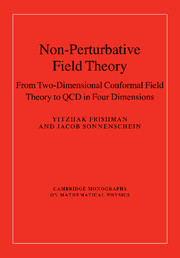PART II - TWO-DIMENSIONAL NON-PERTURBATIVE GAUGE DYNAMICS
Published online by Cambridge University Press: 07 September 2010
Summary
In the first part of the book we have developed several non-perturbative tools for analyzing two-dimensional field theories. These include methods associated with conformal invariance, with affine Lie algebras and in particular the WZW model, techniques of integrable massive theories including solitons, S-matrix and the Yang–Baxter equation, sets of infinitely many conserved charges, the thermal Bethe ansatz, methods of bosonization and the large N limit approximation.
In this second part of the book the main idea is to implement those methods in the context of two-dimensional gauge dynamics aiming at extraction of the mesonic and baryonic spectra of two-dimensional QCD, decoding the confining behavior, versus a screening one, and analyzing models with other quark representations and models of generalized QCD.
The most important tool that will be used for this purpose will be bosonization. It will enable us to easily solve the Schwinger model, derive the baryonic spectrum of QCD2 using a strong coupling limit, determine the screening nature of massless QCD models and compute the string tension for the massive ones. Using the large N approximation we will extract the mesonic spectrum of QCD.
In two respects this part is an intermediate stage on the way to four-dimensional gauge dynamics. Firstly, as was just mentioned, we will gain experience from applying non-perturbative methods on the simpler two-dimensional models, which will serve us when using them in the context of “real” physical systems.
- Type
- Chapter
- Information
- Non-Perturbative Field TheoryFrom Two Dimensional Conformal Field Theory to QCD in Four Dimensions, pp. 175 - 176Publisher: Cambridge University PressPrint publication year: 2010



